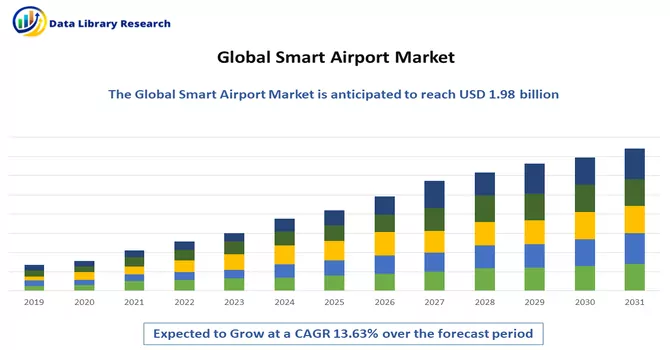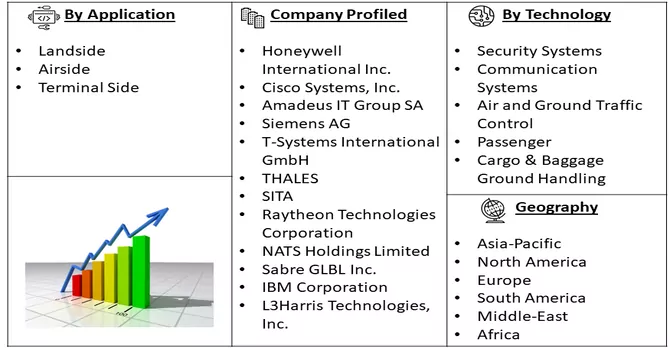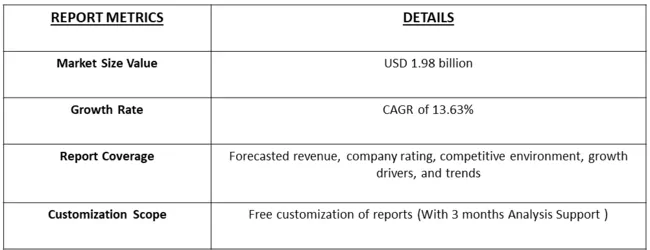The Smart Airport Market size is expected to grow from USD 1.98 billion in 2022 and is expected to register a CAGR of 13.63% during the forecast period (2023-2031)

Get Complete Analysis Of The Report - Download Free Sample PDF
A smart airport refers to an advanced and technologically integrated airport that leverages innovative solutions and digital technologies to enhance operational efficiency, passenger experience, and overall airport management. Smart airports incorporate a wide range of cutting-edge technologies and intelligent systems to optimize various processes and functions, promoting seamless operations and improving the overall travel experience for passengers.
The increasing security threats and the need for robust safety measures drive the adoption of smart airport security solutions. Biometric authentication, advanced surveillance systems, and threat detection technologies enhance overall airport security. Moreover, airports are investing in smart technologies to improve operational efficiency, reduce turnaround times, and optimize resource allocation. This includes automated baggage handling systems, real-time monitoring, and predictive maintenance.
Market Segmentation: The Global Smart Airport Market is Segmented by Technology (Security Systems, Communication Systems, Air and Ground Traffic Control, Passenger, Cargo & Baggage Ground Handling), and by Geography (North America, Europe, Asia-Pacific, Latin America, and Middle East and Africa). The report offers the market size and forecasts in value (USD billion) for all the above segments.

For Detailed Market Segmentation - Download Free Sample PDF
The COVID-19 pandemic has accelerated the adoption of contactless and touchless solutions at airports. Biometric authentication, mobile check-in, and automated processes have gained prominence as airports prioritize passenger safety and hygiene. The increasing demand for air cargo transportation, driven by e-commerce and global trade, contributes to the adoption of smart technologies in cargo handling and logistics at airports. Thus, these market trends are expected to drive the growth of the studied market over the forecast period.
Market Drivers:
Growing Air Cargo Demand
The surge in demand for air cargo transportation, fueled by the growth of e-commerce and global trade, has become a significant catalyst for the adoption of smart technologies in cargo handling and logistics at airports. This trend reflects the evolving landscape of the aviation industry, where the efficient movement of goods has become a critical component of overall operational success. The rapid expansion of e-commerce platforms has led to a substantial increase in the volume of goods being transported by air. Consumers now expect faster and more reliable delivery services, prompting the need for advanced cargo handling solutions to meet these expectations. The interconnectedness of economies and the growth of global trade contribute to a higher demand for air cargo services. As businesses engage in cross-border transactions and supply chains become more complex, airports must deploy smart technologies to handle increased cargo volumes efficiently. Thus, owing to such advantages, the market is expected to witness significant growth over the forecast period.
Automated Ground Handling
The integration of data analytics and predictive maintenance algorithms enables proactive maintenance of ground handling equipment. Automated systems can monitor the condition of equipment, detect potential issues, and schedule maintenance activities in advance. This predictive approach helps minimize unplanned downtime and ensures the reliability of ground-handling operations. Thus, overall, the incorporation of autonomous vehicles, robotics, and automated systems in ground handling activities at airports represents a paradigm shift towards more efficient, reliable, and technologically advanced aviation operations. This transformation contributes to the optimization of resources, improved safety, and a reduction in turnaround times, ultimately enhancing the overall performance of airports and the aviation industry.
Market Restraints:
High Cost and Interoperability Challenges
Smart airports often rely on technology vendors for the development, maintenance, and updates of their systems. Dependence on a limited number of providers may pose challenges in terms of service reliability, support, and flexibility. The implementation of smart airport technologies often requires significant upfront investments in infrastructure, hardware, and software. High initial costs can act as a deterrent, particularly for smaller airports with limited budgets, slowing down the adoption rate.
The imposition of travel restrictions and lockdowns during the pandemic led to a substantial decline in passenger air travel. This reduction in passenger traffic directly impacted the demand for smart airport technologies, as airports faced decreased operational needs and delayed investment decisions. Many airports experienced financial strain due to the decline in revenue from reduced passenger numbers and disruptions in ancillary services. This financial pressure made it challenging for airports to allocate budgets for the implementation of smart technologies. As the aviation industry works towards recovery, smart airport initiatives are regaining attention. Airports are reassessing their technological roadmaps to align with the evolving needs of the post-pandemic travel landscape, emphasizing resilience, flexibility, and passenger-centric solutions.
Segmentation Analysis:
Air and Ground Traffic Control Segment is Expected to Witness Significant Growth over the Forecast Period
Smart airports leverage advanced technologies to transform traditional air and ground traffic control processes, enhancing efficiency, safety, and overall operational performance. The integration of smart technologies in air and ground traffic control is a key component of the broader initiative to create intelligent and connected airport ecosystems. Smart airports incorporate advanced automation and digital communication systems in air traffic control towers. Automated systems assist air traffic controllers in managing and optimizing aircraft movements, improving precision in take-offs, landings, and routing. Ground traffic control is closely integrated with terminal operations. Smart airports synchronize ground movements with gate assignments, baggage handling, and passenger boarding processes, ensuring a seamless and well-coordinated airport operation. Thus, such factors are expected to witness significant growth over the forecast period.
Asia-Pacific Region is expected to Witness Significant Growth over the Forecast Period
The Asia-Pacific region is poised for substantial growth, driven by robust investments in the construction of new airports and the expansion of existing ones. Notably, countries such as China, India, Japan, and South Korea have witnessed a significant surge in passenger traffic in recent years. In response to this escalating demand, governments and airport authorities across the region have announced noteworthy investments in airport infrastructure.
In tandem with infrastructure expansion, regional airports are integrating smart solutions to enhance operational efficiency and ensure uninterrupted services for passengers. A notable example is Delhi International Airport Limited (DIAL), which announced in January 2022 the installation of an Integrated Cart System (ICS) at Terminal 1 of the Delhi Airport. This system, designed for baggage handling, boasts high speed, high capacity, and enhanced reliability. Investments in advanced passenger and baggage handling systems are anticipated to drive growth in this segment in the foreseeable future. The modernization of airport infrastructure through the incorporation of smart solutions is expected to further propel market expansion in the Asia-Pacific region throughout the forecast period.

Get Complete Analysis Of The Report - Download Free Sample PDF
The smart airports market exhibits a high degree of fragmentation, characterized by the presence of numerous players offering sophisticated smart technology solutions. This fragmented landscape signifies a diverse array of companies contributing to the development and implementation of advanced technologies within the smart airports sector. The multitude of players underscores the dynamic and competitive nature of the market, with each participant contributing unique innovations and solutions to the evolving landscape of smart airport technologies. Some of the key market players are:
Recent Development:
1) In February 2023, Smiths Detection, a renowned provider of threat detection and security inspection technologies, secured a contract from New Zealand's Aviation Security Service (AvSec). The contract encompasses the delivery of state-of-the-art checkpoint security technology to five major international airports in the country, namely Auckland, Christchurch, Dunedin, Queenstown, and Wellington.
2) In June 2022, Fiumicino Airport in Italy unveiled plans for an innovative baggage handling system. This comprehensive system includes advanced baggage sorting and hold baggage systems (HBS) designed to subject 100% of departing baggage to X-ray control for enhanced security measures.
Q1. What was the Smart Airport Market size in 2022?
As per Data Library Research the Smart Airport Market size is expected to grow from USD 1.98 billion in 2022.
Q2. At what CAGR is the Smart Airport Market projected to grow within the forecast period?
Smart Airport Market is expected to register a CAGR of 13.63% during the forecast period.
Q3. What are the factors driving the Smart Airport market?
Key factors that are driving the growth include the Growing Air Cargo Demand and Automated Ground Handling.
Q4. Which Region is expected to hold the highest Market share?
Asia-Pacific region is expected to hold the highest Market share.
Data Library Research are conducted by industry experts who offer insight on industry structure, market segmentations technology assessment and competitive landscape (CL), and penetration, as well as on emerging trends. Their analysis is based on primary interviews (~ 80%) and secondary research (~ 20%) as well as years of professional expertise in their respective industries. Adding to this, by analysing historical trends and current market positions, our analysts predict where the market will be headed for the next five years. Furthermore, the varying trends of segment & categories geographically presented are also studied and the estimated based on the primary & secondary research.
In this particular report from the supply side Data Library Research has conducted primary surveys (interviews) with the key level executives (VP, CEO’s, Marketing Director, Business Development Manager and SOFT) of the companies that active & prominent as well as the midsized organization
FIGURE 1: DLR RESEARH PROCESS

Extensive primary research was conducted to gain a deeper insight of the market and industry performance. The analysis is based on both primary and secondary research as well as years of professional expertise in the respective industries.
In addition to analysing current and historical trends, our analysts predict where the market is headed over the next five years.
It varies by segment for these categories geographically presented in the list of market tables. Speaking about this particular report we have conducted primary surveys (interviews) with the key level executives (VP, CEO’s, Marketing Director, Business Development Manager and many more) of the major players active in the market.
Secondary ResearchSecondary research was mainly used to collect and identify information useful for the extensive, technical, market-oriented, and Friend’s study of the Global Extra Neutral Alcohol. It was also used to obtain key information about major players, market classification and segmentation according to the industry trends, geographical markets, and developments related to the market and technology perspectives. For this study, analysts have gathered information from various credible sources, such as annual reports, sec filings, journals, white papers, SOFT presentations, and company web sites.
Market Size EstimationBoth, top-down and bottom-up approaches were used to estimate and validate the size of the Global market and to estimate the size of various other dependent submarkets in the overall Extra Neutral Alcohol. The key players in the market were identified through secondary research and their market contributions in the respective geographies were determined through primary and secondary research.
Forecast Model
